Welcome MAT 1375 Faculty! This Course Hub is intended as a central repository of resources for the course. Announcements for all faculty teaching the course will be posted here.
Author: Jonas Reitz (Page 1 of 2)
Hi everyone! Read through the material below, watch the videos.
Lesson 24: The geometric series
Topic: This lesson covers Chapter 24: The geometric series
WeBWorK: There are two WeBWorK assignments on today’s material:
Sequences – Geometric
Series – Geometric
Question of the day: Can we add up infinitely many numbers?
Lesson Notes (Notability – pdf):
This .pdf file contains most of the work from the videos in this lesson. It is provided for your reference.
Finite geometric series
Today we look at a new kind of sequence, called a geometric sequence, and the corresponding series, geometric series.
A geometric sequence is a sequence for which we multiply by a constant number to get from one term to the next, for example:

Definition 24.1. A sequence
Alternatively, we have the general formula for the
Example 24.2. Determine if the sequence is a geometric or arithmetic sequence, or neither or both. If it is a geometric or arithmetic sequence, then find the general formula.
a)
b)
c)
d)
e)
f)
g)
h)
VIDEO: Introduction to geometric sequences, Example
Example 24.3. Find the general formula of a geometric sequence with the given property
a)
b)
c)
VIDEO: Finding the formula of a geometric sequence – Example 24.3
Example 24.4. Consider the geometric sequence
Find the sum of the first 6 terms of this sequence
VIDEO: Sum of a geometric series – intro example
Observation 24.5. Let
Example 24.6. Find the value of the geometric series.
a) Find the sum
b) Determine the value of the geometric series:
c) Find the sum of the first 12 terms of the geometric sequence
VIDEO: The sum of a finite geometric series, Example 24.6
Infinite geometric series
Sometimes it makes sense to add up not just a finite number of terms in a sequence, but ALL the terms (infinitely many!).
Example 24.7. Consider the geometric sequence
What is the initial term? What is the common ratio?
Let’s try adding up some of the terms. Try this by hand, and by using the formula for finite geometric series. What happens if we add up ALL the terms?
VIDEO: Infinite geometric series – intro example and formula
Definition 24.8. An infinite series is given by the formula
Observation 24.9. Let
Example 24.10. Find the value of the infinite geometric series.
a)
b)
c)
d)
Example 24.11. Consider the real number given by
VIDEO: Infinite geometric series – examples
Hi everyone! Read through the material below, watch the videos!
Lesson 23: Sequences and series
Topic: This lesson covers Chapter 23: Sequences and series
WeBWorK: There are three WeBWorK assignments on today’s material:
Sequences – Introduction
Sequences – Arithmetic
Series – Finite Arithmetic
Question of the day: What is a sequence? What is a series?
Answer of the day: A sequence is just a list of numbers. A series is list of numbers, added up.
Lesson Notes (Notability – pdf):
This .pdf file contains most of the work from the videos in this lesson. It is provided for your reference.
Introduction to sequences and series
Today we will introduce two very powerful ideas (they are the building blocks of Calculus) – however, the ideas themselves are not complicated: sequences and series. They both have to do with lists of numbers, rather than individual numbers.
Definition 23.1. A sequence is an ordered list of numbers (we call each number in the list a term in the sequence). We write a sequence in order as follows:
In short we write the above sequence as
Let’s look at examples of some sequences. As you look at this example, keep the following questions in mind:
- Is there a pattern in the sequence?
- Can you predict what the next term of the sequence will be?
- Can you predict what the 10th term of the sequence will be? What about the 20th, or the 100th?
- Can you find a formula for
Example 23.2. Here are some examples of sequences.
a)
b)
c)
d)
e)
Example 23.3. Consider the sequence
VIDEO: Introduction to sequences – Examples 23.2 and 23.3
Example 23.4. Find the first 6 terms of each sequence.
a)
b)
c)
d)
Another way to describe a sequence is by giving a recursive formula for the
Example 23.6. Find the first
a)
b)
c)
VIDEO: Two ways of describing sequences -Examples 23.4 and 23.6
Definition 23.8. A series is a sum of terms in a sequence. We denote the sum of the first
The summation symbol
Example 23.9. Find the sum.
a)
b)
c)
VIDEO: Intro to series – Example 23.9
The arithmetic sequence
Definition 23.10. A sequence
Alternatively, we have the general formula for the
Example 23.11. Determine if the sequence is an arithmetic sequence. If so, then find the general formula for
a)
b)
c)
d)
VIDEO: Arithmetic sequences – Example 23.11
Example 23.12. Find the general formula of an arithmetic sequence with the given property.
a)
b)
c)
VIDEO: Arithmetic sequences – finding a general formula, Example 23.12
Example 23.13. Find the sum of the first 100 integers, starting from 1 . In other words, we want to find the sum of
VIDEO: Arithmetic series – intro example 23.13
Observation 23.14 . Let
Example 23.15. Find the value of the arithmetic series.
a) Find the sum
b) Determine the value of the sum:
c) Find the sum of the first 35 terms of the sequence
VIDEO: Arithmetic series – finding the sum, Example 23.15
Hi everyone! Read through the material below, watch the videos.
Lesson 22: Vectors in the plane
Topic: This lesson covers Chapter 22: Vectors in the plane.
WeBWorK: There are four WeBWorK assignments on today’s material:
Vectors – Components
Vectors – Operations
Vectors – Magnitude and Direction
Vectors – Unit Vectors
Lesson Notes (Notability – pdf):
This .pdf file contains most of the work from the videos in this lesson. It is provided for your reference.
Introduction to Vectors
Today we will be working with the plane
Definition 22.1. A geometric vector in the plane is a geometric object in the plane
Vectors are often drawn as directed line segments
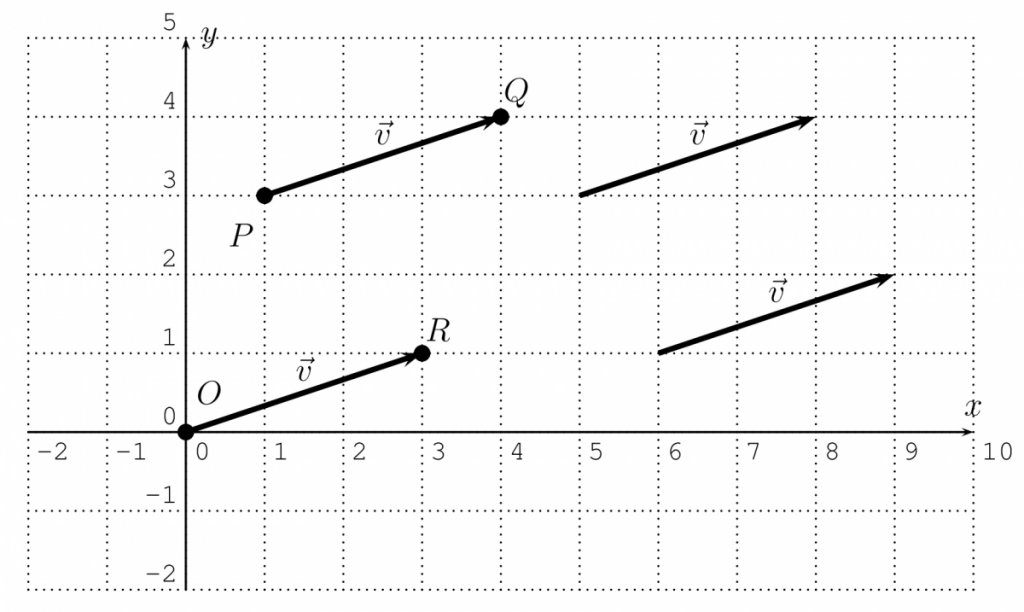
We can always represent a vector
Example 22.2. Graph the vectors
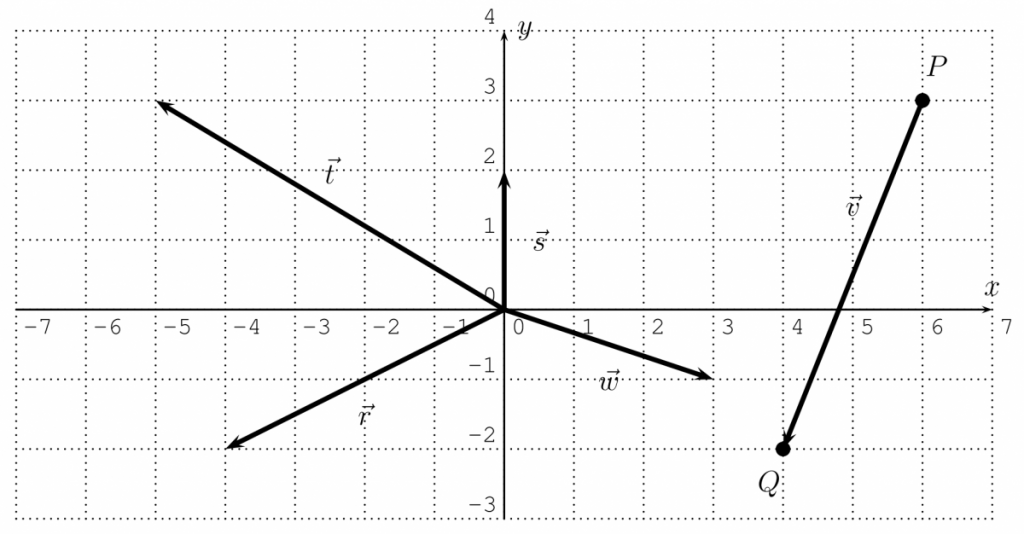
The formulas for magnitude and directional angle of a vector are the same as those for modulus (magnitude) and argument (angle) of a complex number:
Formulas for magnitude and angle of a vector: Suppose
Conversely, we can obtain the coordinates of a vector from its magnitude and directional angle by:
Example 22.4. Find the magnitude and directional angle of the given vectors:
a)
b)
c)
d)
e)
VIDEO: Intro to vectors, finding magnitude and direction – Example 22.4
Operations on Vectors
There are two basic operations on vectors, scalar multiplication and vector addition.
Scalar Multiplication
Definition 22.5. The scalar multiplication of a real number
Example 22.6. Multiply, and graph the vectors
a)
b)
VIDEO: Scalar multiplication of vectors – Example 22.6
Observation. When we multiply a vector
The Unit Vector
Definition 22.8. A vector
There are two special unit vectors
Example 22.9. Find a unit vector in the direction of
a)
b)
VIDEO: Unit vectors – Example 22.9
Vector Addition
The second operation on vectors is called vector addition.
Definition 22.10. Let
In the plane, this corresponds to starting at the origin, following
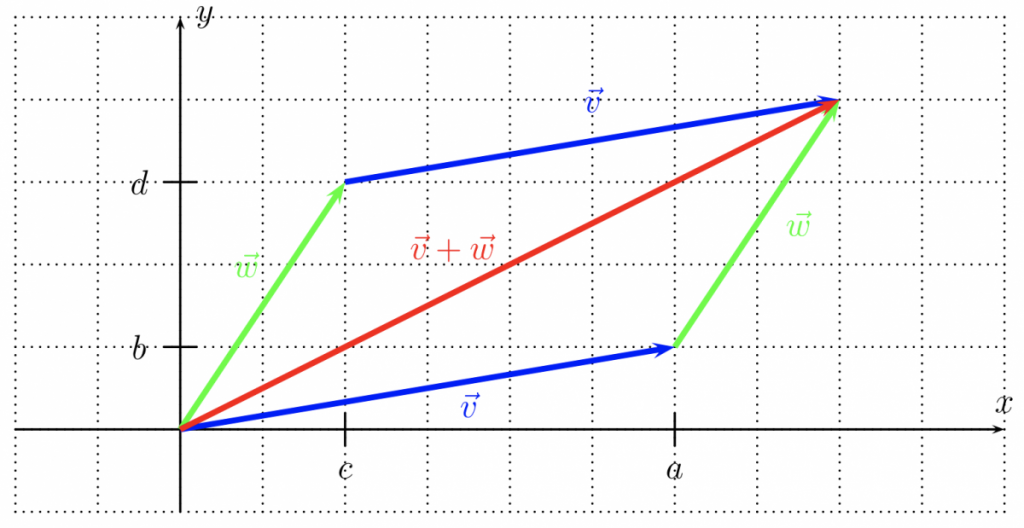
Example 22.11. Perform the vector addition and simplify as much as possible.
a)
b)
c)
d) find
e) find
VIDEO: Vector addition – Example 22.11
Example 22.12. The forces
a)
b)
VIDEO: Vector addition application (force) – Example 22.12
That’s it for now – give the WeBWorK a try!
Hi everyone! Read through the material below, watch the videos.
Lesson 21: Complex Numbers
Topic: This lesson covers Chapter 21: Complex numbers.
WeBWorK: There are four WeBWorK assignments on today’s material:
Complex Numbers – Operations
Complex Numbers – Magnitude
Complex Numbers – Direction
Complex Numbers – Polar Form
Question of the Day: What is the square root of
Lesson Notes (Notability – pdf):
This .pdf file contains most of the work from the videos in this lesson. It is provided for your reference.
Review of Complex Numbers
How do we get the complex numbers? We start with the real numbers, and we throw in something that’s missing: the square root of
Definition 21.1. We define the imaginary unit or complex unit to be:
The most important property of
Definition 21.2. A complex number is a number of the form
We can picture the complex number
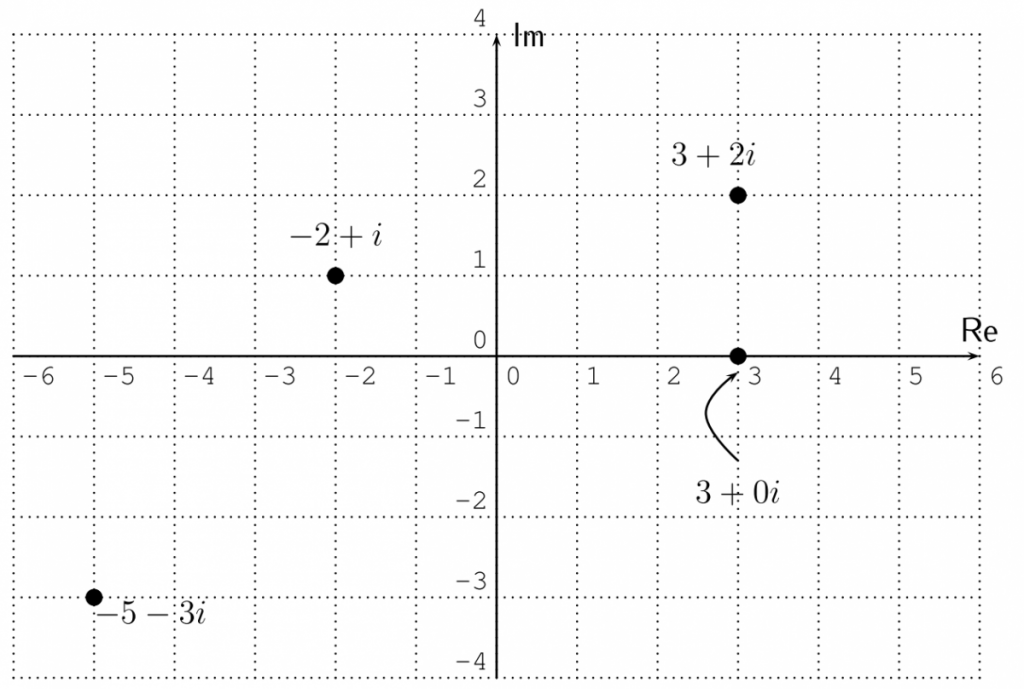
Example 21.3. Perform the operation.
a)
b)
c)
VIDEO: Review of Complex Numbers – Example 21.3
Polar form
Next, we will look at how we can describe a complex number slightly differently – instead of giving the
Many amazing properties of complex numbers are revealed by looking at them in polar form! Let’s learn how to convert a complex number
Definition 21.4. Let
Definition 21.6. Let

As shown in the diagram, the coordinates
Substituting and factoring out
Polar form:
How do we find the modulus
Note that
Formulas for converting to polar form (finding the modulus
With regards to the modulus
If
Example 21.7. Convert the complex number to polar form.
a)
b)
c)
d)
VIDEO: Converting complex numbers to polar form – Example 21.7
Example 21.8. Convert the number from polar form into the standard form
a)
b)
VIDEO: Converting complex numbers from polar form into standard form – Example 21.8
Multiplication and division of complex numbers in polar form
Why is polar form useful? The primary reason is that it gives us a simple way to picture how multiplication and division work in the plane. The proposition below gives the formulas, which may look complicated – but the idea behind them is simple, and is captured in these two slogans:
When we multiply complex numbers: we multiply the
When we divide complex numbers: we divide the
Proposition 21.9. Let
Example 21.10. Multiply or divide the complex numbers, and write your answer in polar and standard form.
a)
b)
c)
d)
e) INTUITIVE BONUS: Without doing any calculation or conversion, describe where in the complex plane to find the number obtained by multiplying
VIDEO: Multiplication and division of complex numbers in polar form – Example 21.10
That’s it for today! Give the WeBWorK a try.
Hi everyone! Read through the material below, watch the videos, and send me your questions. Don’t forget to complete the Daily Quiz (below this post) before midnight to be marked present for the day.
Lesson 20: Trigonometric Equations
Lesson Date: Thursday, April 23rd.
Topic: This lesson covers Chapter 20: Trigonometric Equations.
WeBWorK: There is one WeBWorK assignment on today’s material, due next Thursday 4/30:
Trigonometry – Equations
Question of the Day: If we know
Lesson NOtes (Notability – pdf):
This .pdf file contains most of the work from the videos in this lesson. It is provided for your reference.
Basic Trigonometric Equations
Equations of the form tan(x)=c
Example 20.1. Solve for
VIDEO: Example 20.1, tan(x)=c
Observation 20.2. To solve
EQUATIONS OF THE FORM cos(x)=c
Example 20.4. Solve for
VIDEO: Example 20.4, cos(x)=c
Observation 20.5. To solve
EQUATIONS OF THE FORM sin(x)=c
Example 20.7. Solve for
VIDEO: Example 20.7, sin(x)=c
Observation 20.8. To solve
Summary: We summarize the different formulas used to solve the basic trigonometric equations in the following table.
| Solve: | Solve: | Solve: |
| First, find one solution, that is: | First, find one solution, that is: | First, find one solution, that is: |
| The general solution is: | The general solution is: | The general solution is: |
| where | where | where |
Example 20.10. Find the general solution of the equation, and state at least
a)
b)
Equations involving trigonometric functions
Example 20.11. Solve for
a)
b)
c)
VIDEO: Example 20.11 – equations with trig functions (linear)
Example 20.12. Solve for
a)
VIDEO: Example 20.12 – equations with trig functions (quadratic)
Hi everyone! Read through the material below, watch the videos.
Lesson 19: Inverse trigonometric functions
Topic: This lesson covers Chapter 19: Inverse trigonometric functions.
WeBWorK: There is one WeBWorK assignment on today’s material:
Trigonometry – Inverse Functions
Question of the Day: Are the trigonometric functions
Lesson Notes (Notability – pdf):
This .pdf file contains most of the work from the videos in this lesson. It is provided for your reference.
The functions
In this section, we are interested in the inverse functions of the trigonometric functions
The function
Recall the graph of the function
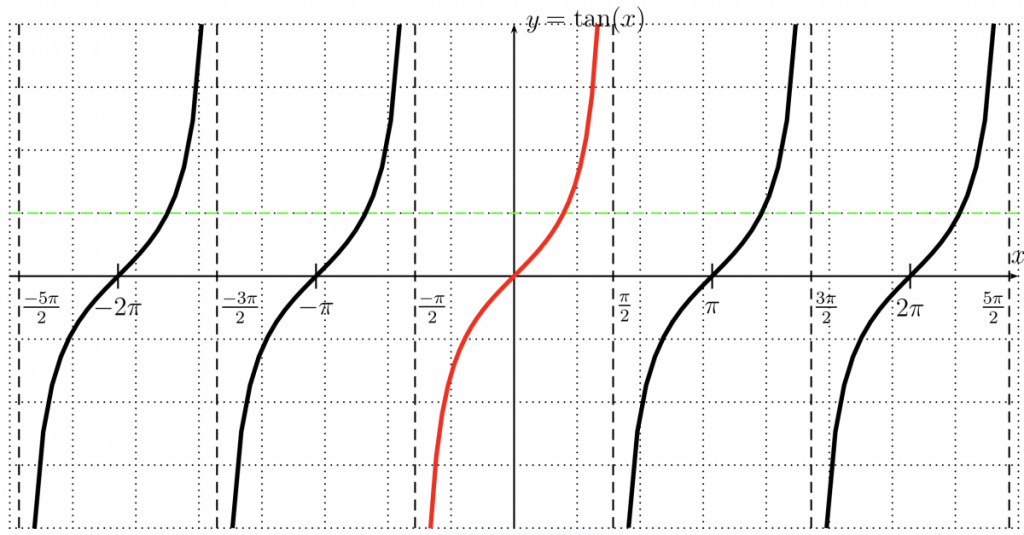
Notice that since the graph consists of a repeating pattern of vertical stripes, any horizontal line will touch the graph in multiple places – this graph FAILS the horizontal line test (it is NOT one-to-one). How can we define the inverse? By restricting the domain – that is, only looking at one of the repeating vertical stripes. If we only look at the part of the graph between
Definition 19.1. The inverse of the function
Note that the inverse tangent function is written both
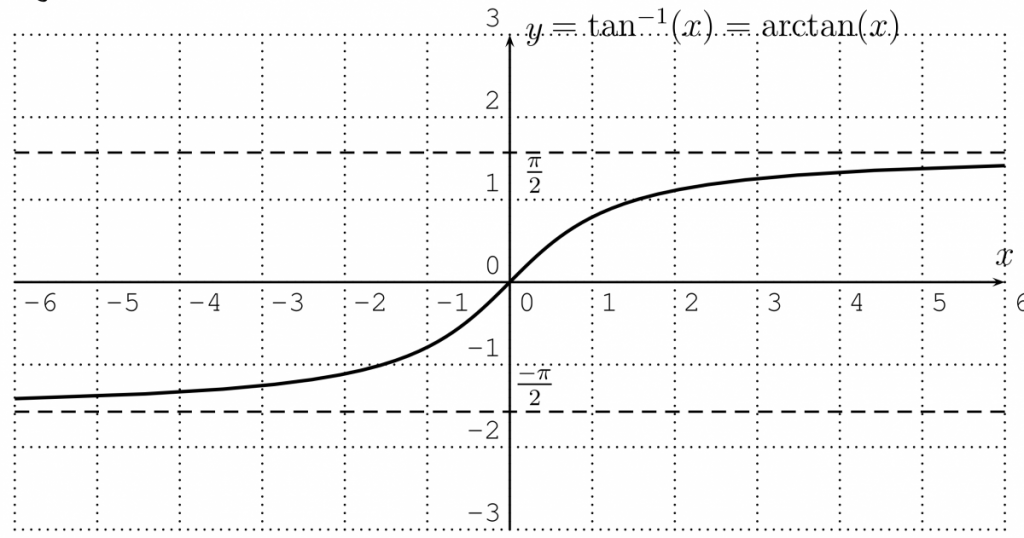
Observation: The inverse tangent is an odd function, so
(recall that a function
Example 19.1 Recall the exact values of the tangent function from Chapter 17:

Use the table and Observation above to find exact values of the inverse tangent function. Give answers in both degrees and radians.
a.
VIDEO: The Inverse Tangent Function – Definition and Example 19.1
THE FUNCTION
Consider the graph of the function

However, if we restrict the function to the interval
Definition 19.5. The inverse of the function
The arcsine reverses the input and output of the sine function, so that the arcsine has domain

Observation: The inverse sine function is an odd function, so
Example 19.7. Recall the values of the sine function for common angles:

Use the Table and Observation above to find exact values of the arcsine function. Give answers in both degrees and radians.
a.
VIDEO: The Inverse Sine Function – Definition and Example 19.7
THE FUNCTION
We treat the function

In order to make the cosine function one-to-one, we restrict to the interval
Definition 19.8. The inverse of the function
The arccosine reverses the input and output of the cosine function, so that the arccosine has domain

Observation: The arccosine function is neither even nor odd. However, it does obey the following symmetry:
(in many problems, you can avoid the use of this formula by remembering the unit circle definition of cosine).
Example 19.10. Recall the values of the cosine function for common angles:

Use the Table and Observation above to find exact values of the arccosine function. Give answers in both degrees and radians.
a.
VIDEO: The Inverse Cosine Function – Definition and Example 19.10
Inverse trig functions on the TI-84+ calculator
How do we find values of inverse trig functions that don’t appear in our “common angles” table?
Example. Find the values of the inverse trig functions using a calculator. Include at least 5 decimal digits past the decimal point.
a.
b.
VIDEO: Inverse trig functions on the calculator
RECALL: Converting between radians and degrees
Hi everyone! Read through the material below, watch the videos, collect your questions.
Lesson 18: Addition of angles and multiple angle formulas
Topic: This lesson covers Chapter 18: Addition of angles and multiple angle formulas.
WeBWorK: There are two WeBWorK assignments on today’s material:
Trigonometry – Sum and Difference Formulas
Trigonometry – Double and Half Angle Formulas
Lesson Notes (Notability – pdf):
This .pdf file contains most of the work from the videos in this lesson. It is provided for your reference.
Question of the Day: Suppose we know the values of the trig functions of two angles
Today, we will see how we can do exactly that – the idea is to work with formulas that allow us to calculate, for example,
NOTE: We often use greek letters for angles — this helps us keep track of what’s an angle and what’s not. The most common are the greek letters alpha
Warning: the videos for today’s lecture are *quite long* – however, they consist almost entirely of examples, with a lot of explanation. Feel free to skip around, or to try the WeBWorK first (if you get stuck, the videos might help).
Addition and Subtraction of Angles
Proposition 18.1. For any angles
Where did these formulas come from!?
Great question! To answer it, you need to see the *proof* of these formulas – this appears in your book in Chapter 18.
Now, we are going to see how these formulas let us calculate the values of trig functions at many different angles, based on just a few common angles (such as those listed in the table below – if you don’t know them, this is a great time to learn them!).

Example 18.2. Find the exact values of the trigonometric functions:
a)
b)
c)
VIDEO: Example 18.2 applying angle sum and difference formulas
Double and Half Angles
Proposition 18.5. Let
and the double-angle formulas:
Example 18.6. Find the exact values of the trigonometric functions:
a)
b)
c)
VIDEO: Example 18.6 applying half-angle formulas
Example 18.7. Find the trigonometric functions of
a)
b)
VIDEO: Example 18.7 applying double-angle formulas
That’s it for now. Take a look at the WeBWorK!
Hi everyone! Read through the material below, watch the videos, and collect your questions.
Lesson 17: Trigonometric functions
Topic: This lesson covers Chapter 17: Trigonometric functions.
WeBWorK: There are five WeBWorK assignments on today’s material:
Trigonometry - Unit Circle,Trigonometry - Graphing Amplitude,Trigonometry - Graphing Period,Trigonometry - Graphing Phase Shift, andTrigonometry - Graphing Comprehensive
Today we start trigonometric functions. We’ll begin with a review of the basics of trigonometry — if you remember everything about trigonometry, you can skip this part (but please don’t!). Then we’ll think about how these behave as functions, and look at their graphs.
Lesson Notes (Notability – pdf):
This .pdf file contains most of the work from the videos in this lesson. It is provided for your reference.
Review of trigonometry
a. Angles
We measure angles using two different systems, degrees and radians. In degrees, a full circle is
Although most people are more familiar with degrees from their day-to-day lives, most mathematics at this level and above use radians. It will help you to get familiar with common angles in radians! The first video gives a review.
Why do mathematicians and scientists prefer radians to degrees? Great question!
VIDEO: Review of angles, radian measure
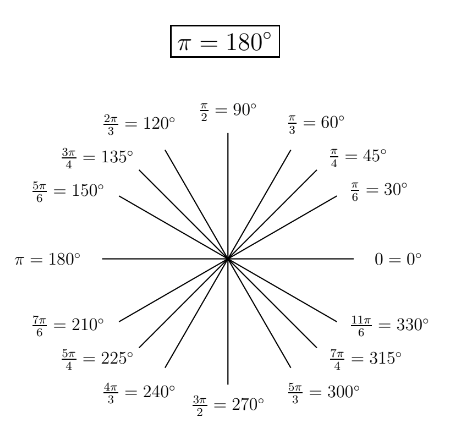
b. Trigonometric Functions
Definition. To define the trigonometric functions, we consider the following diagram: the initial side of an angle

The distance from the origin
VIDEO: Review – definitions of trigonometric functions
Next, we need to know the values of the trig functions for some common angles. Once again, this is a review of material from previous courses – the following video will take you through some examples, but for more details I recommend checking out the videos on our video resource page.
VIDEO: Values of trig functions at common angles


This is the end of the ‘review’ part of the lesson. Need a little more help? Take a look at the videos on our video resource page.
Graphs of trigonometric functions
Now we turn to the main idea of this lesson. We begin by looking at the graphs of the basic trig functions,
VIDEO: Graphs of basic trig functions
Example 17.8. Graph the following functions:
VIDEO: Example 17.8 modifying the graphs of trig functions – amplitude, period, phase shift.
Definition 17.9. Let
The number
That’s it for now. Take a look at the WeBWorK!
Hi everyone! Read through the material below, watch the videos, collect your questions.
Lesson 15-16: Applications of Exponential and Logarithmic Functions
Topic: This lesson covers Chapter 15: Applications of Exponential and Logarithmic Functions and Chapter 16: Half-Life and Compound Interest.
WeBWorK: There is one WeBWorK assignment on today’s material:
Exponential Functions - Growth and Decay.
We study exponential functions because they are amazingly good at describing real-world phenomena. Today we will look at several different applications of exponential functions, including population growth and virus spread.
Lesson Notes (Notability – pdf):
This .pdf file contains most of the work from the videos in this lesson. It is provided for your reference.
Exponential growth and decay
RECALL: If
NOTE: You can determine the values of
Example 15.1.
a)
c)
Example 15.3 The population size of a country was
a) Assuming an exponential growth for the population size, find the formula for the population depending on the year
b) What will the population size be in the year 2015, assuming the formula holds until then?
c) When will the population reach 18 million?
You will often see exponential growth and decay functions written in a slightly different (but equivalent) form, using the number
FACT. If
QUESTION: What’s the connection between
Definition (exponential decay). The half-life of a substance is the time it takes for the amount to be cut in half.
EXAMPLE: A study published on March 17th, in the New England Journal of Medicine found experimentally that the half-life of the Covid-19 virus in the air is approximately 1.15 hours. A single cough by an infected person can release up to 6 billion coronavirus molecules into the air. Let’s consider what happens after a single cough by an infected person.
- a. Model the number of remaining virus molecules
- b. How many of virus molecules will remain viable 5 hours after the person coughed?
- c. How long will it take for the number of remaining molecules to reach
That’s it for now. Take a look at the WeBWorK!


